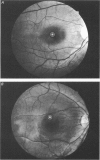Abstract
1. The receptoral mechanisms underlying the vision of two atypical achromats of the complete variety were studied with standard psychophysical procedures. 2. Under scotopic conditions the spectral sensitivity of each achromat was well described by the CIE (Commission Internationale de l'Eclairage) scotopic sensitivity function and the recovery of sensitivity after a retinal bleach showed characteristic duplex behaviour with the time constant of recovery of the slower phase matching that of normal rod vision for both foveal and peripheral stimulation. 3. Their spectral sensitivity was measured under conditions of chromatic adaptation in order to reveal any residual middle or long wavelength cone activity. Only one photopic spectral responses was found and this was adequately described by the spectral sensitivity function of Stiles pi 3 mechanism of normal vision. 4. Increment threshold measurements as a function of background intensity revealed a double-branched function in the fovea. The lower branch was found to have the spectral sensitivity of the rods; the upper branch that of Stiles' pi 3 mechanism. Stiles-Crawford measurements of directional sensitivity confirmed that the branch with the rhodopsin action spectrum had the directional sensitivity of rods and that the branch with the action spectrum of pi 3 had the directional sensitivity of cones. 5. These was no evidence for hue discrimination under photopic conditions. Regions of apparently normal performance on hue discrimination tests on more careful examination could be explained by luminosity judgements mediated by short wavelength-absorbing receptors. 6. We reject the notion of there being rhodopsin-filled cones in the fovea of these subjects. The foveal and peripheral vision of each of these achromats can be adequately described in terms of the participation of only two types of receptor, namely normally functional rods under scotopic conditions and normally functioning short wavelength-absorbing cones under photopic conditions. They are therefore functional blue mono-cone monochromats, an explanation which was originally proposed by Blackwell & Blackwell (1957) over thirty years ago.
Full text
PDF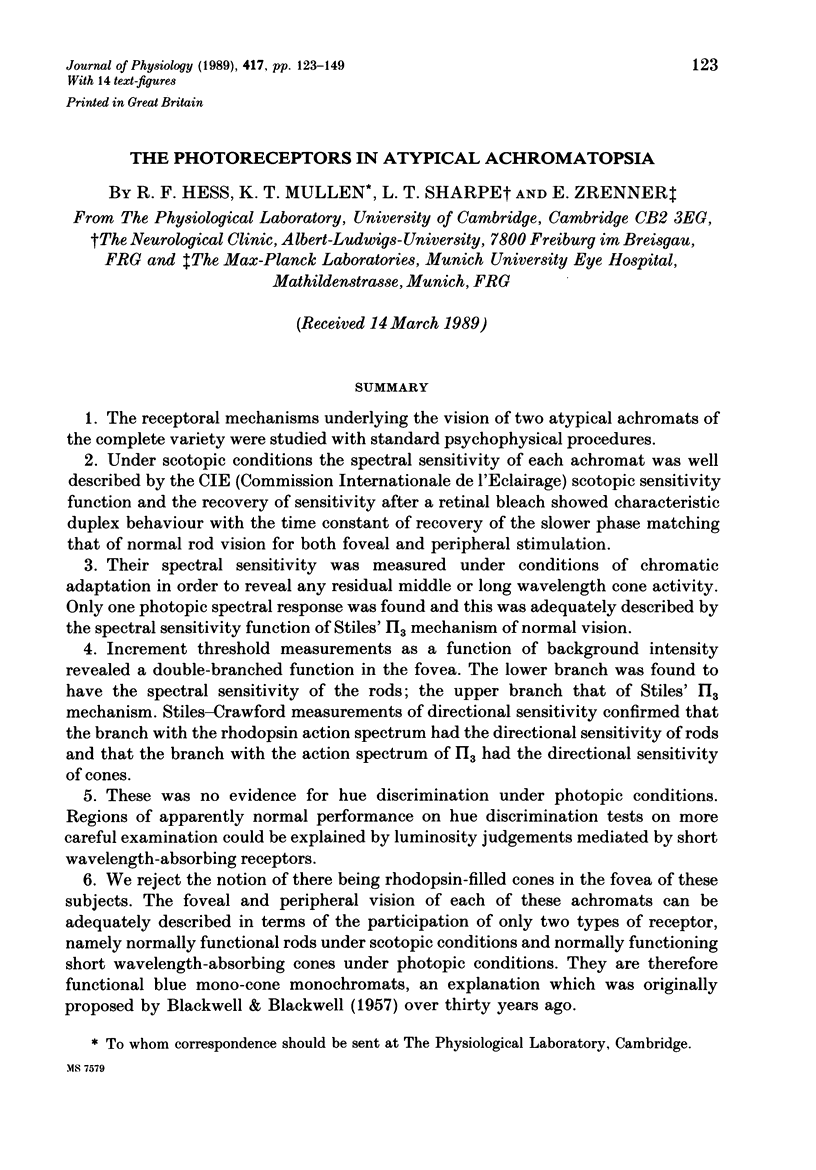
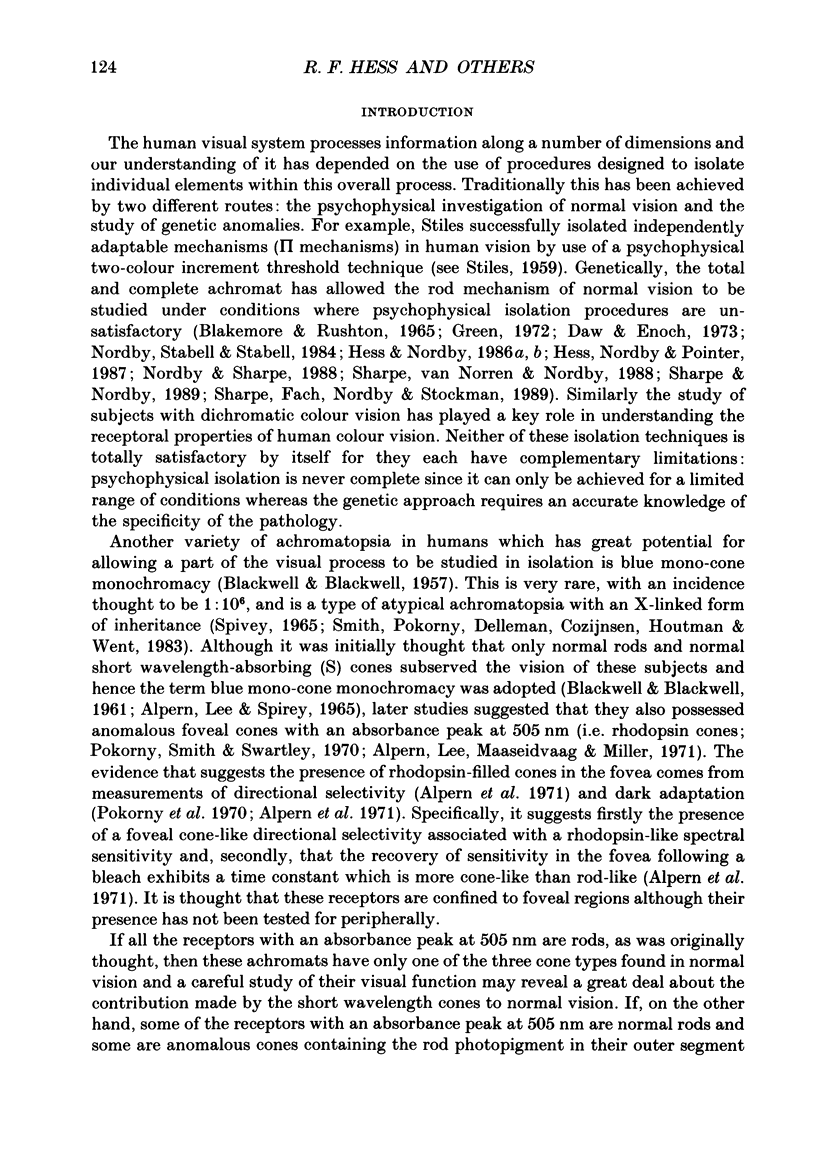
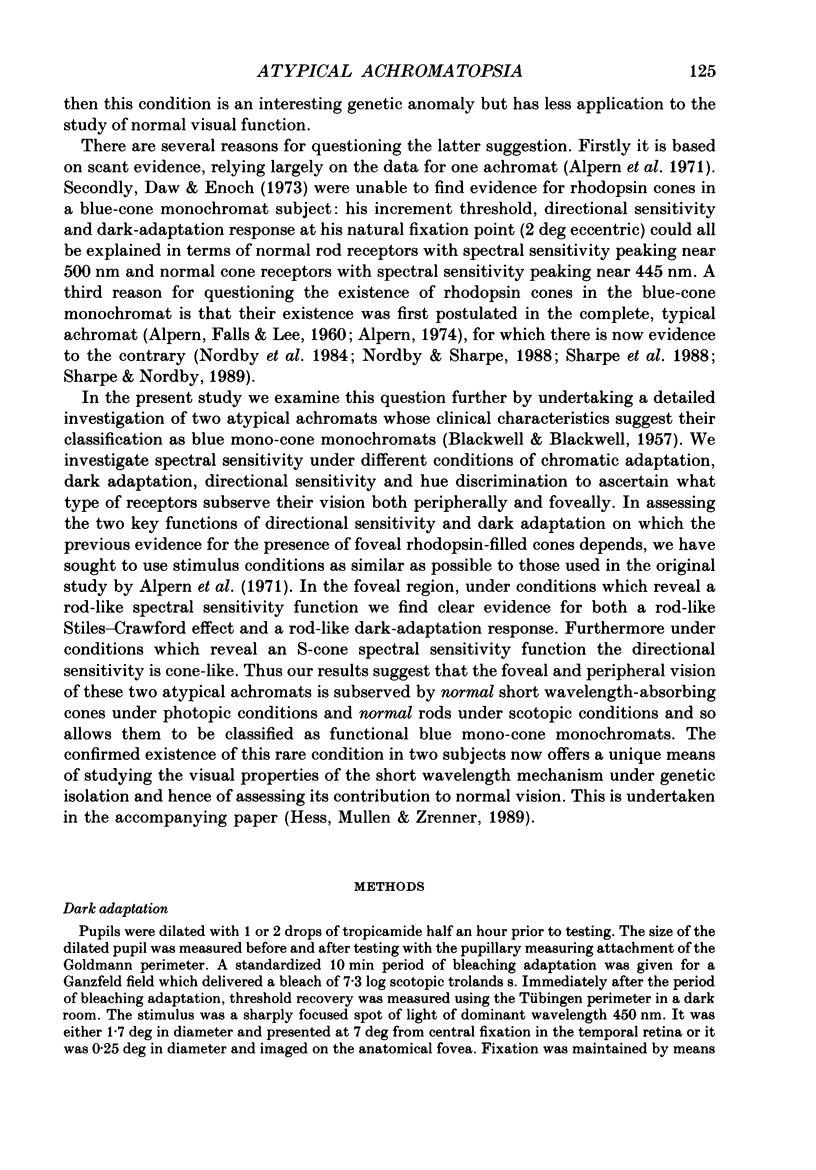
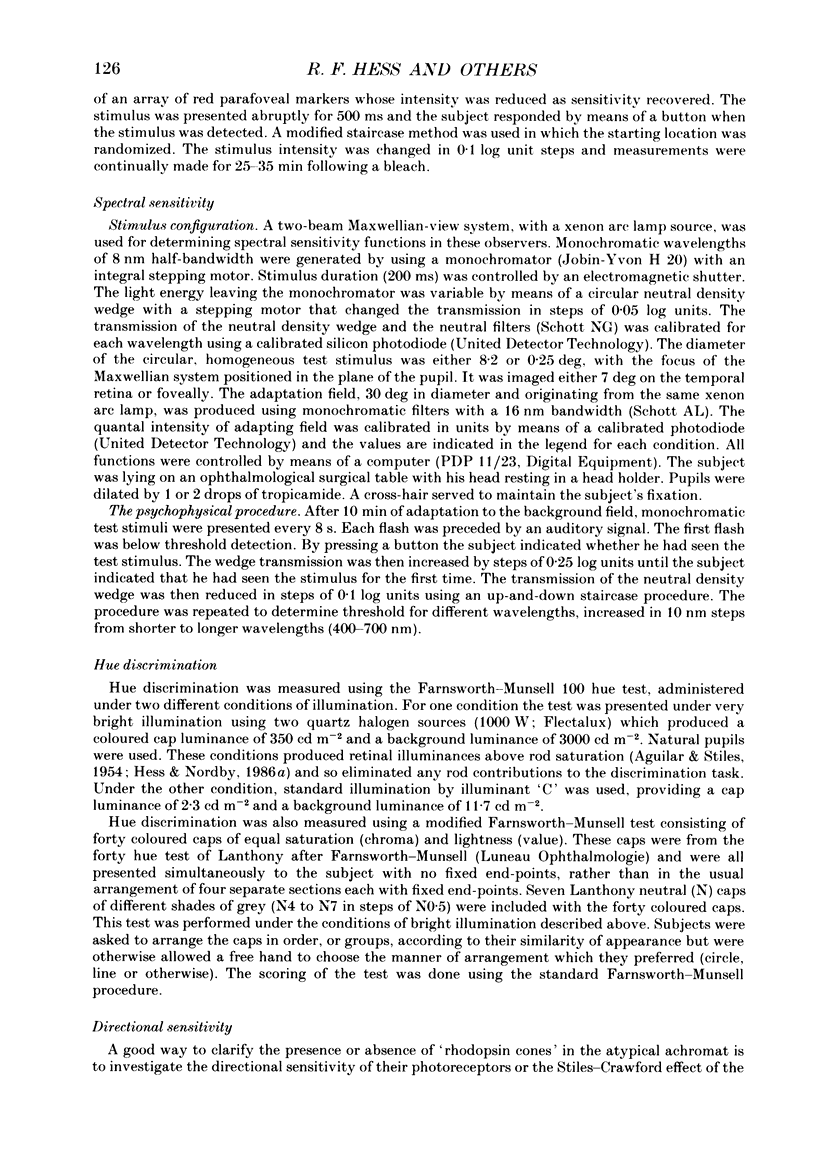
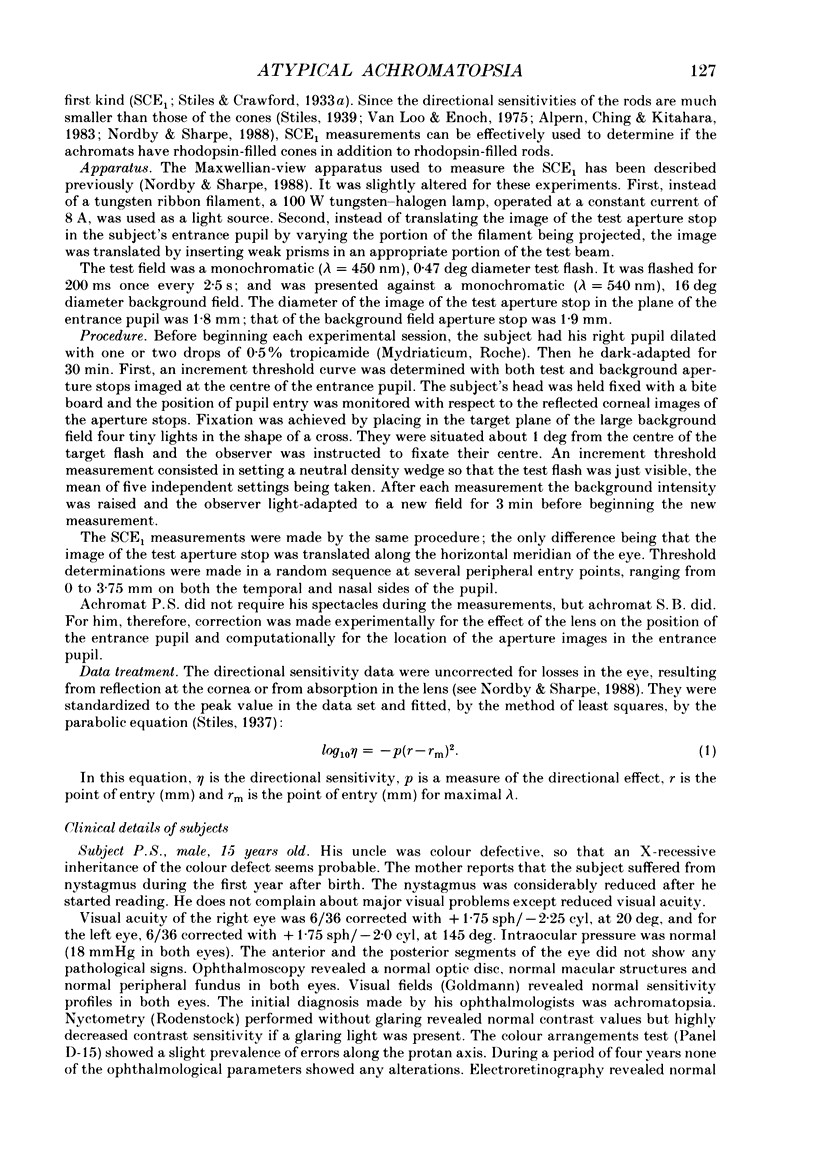
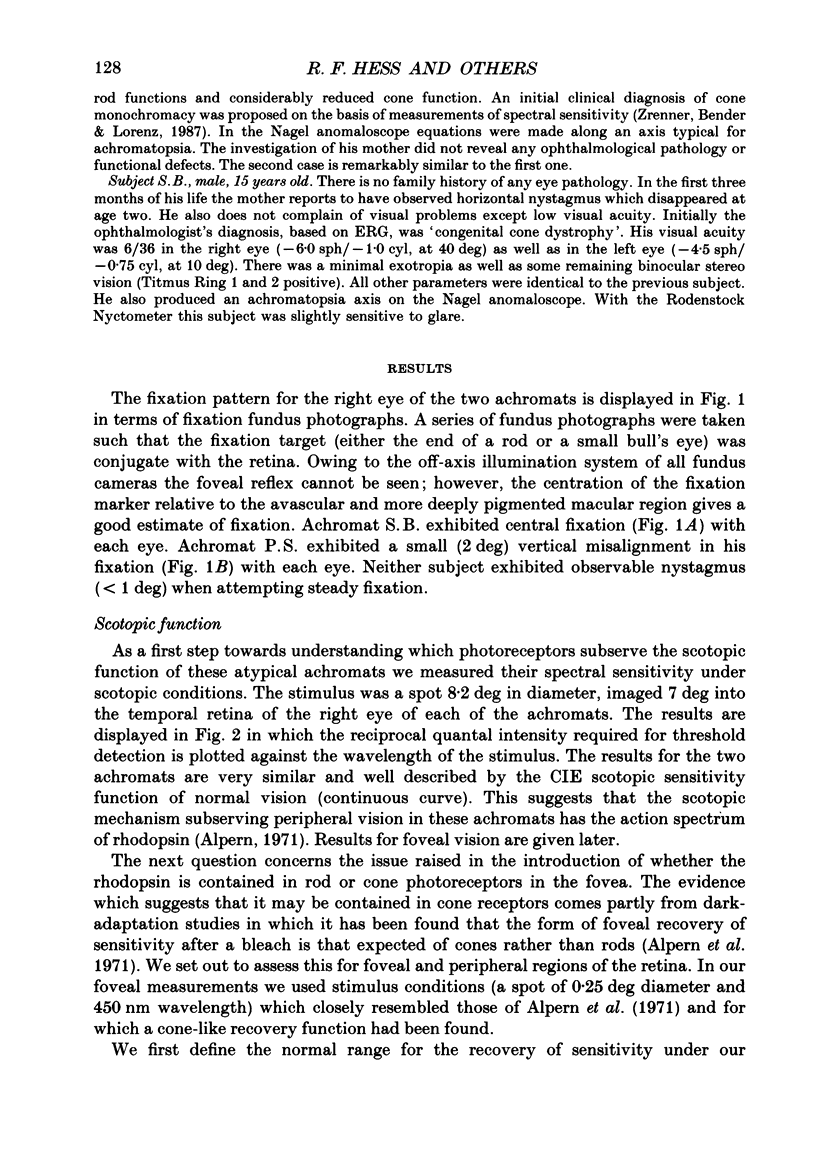
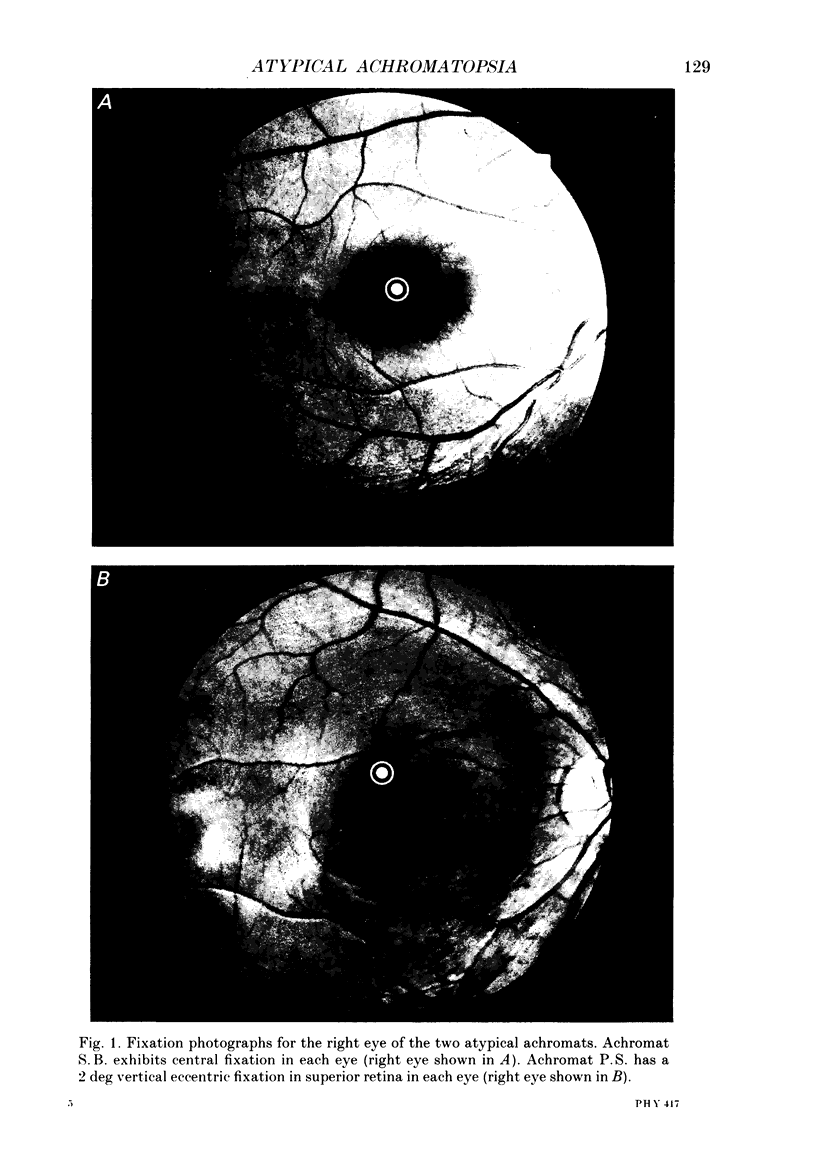
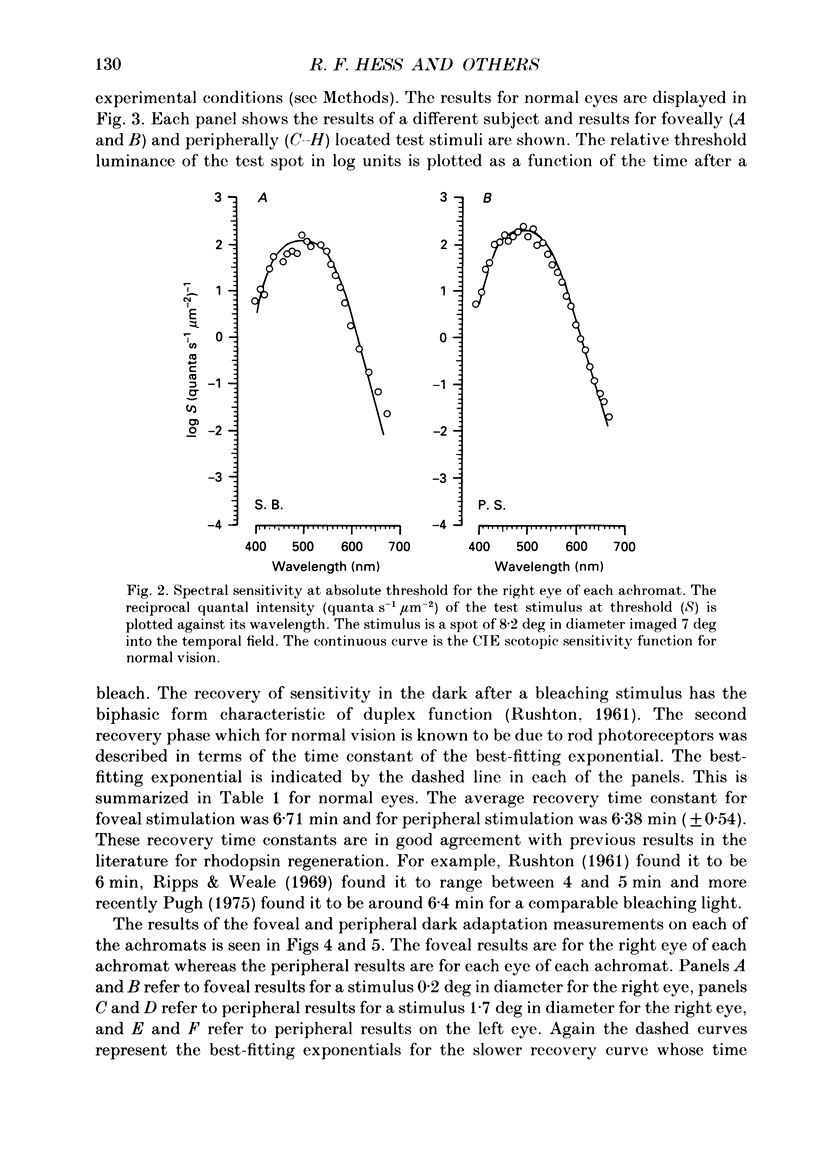
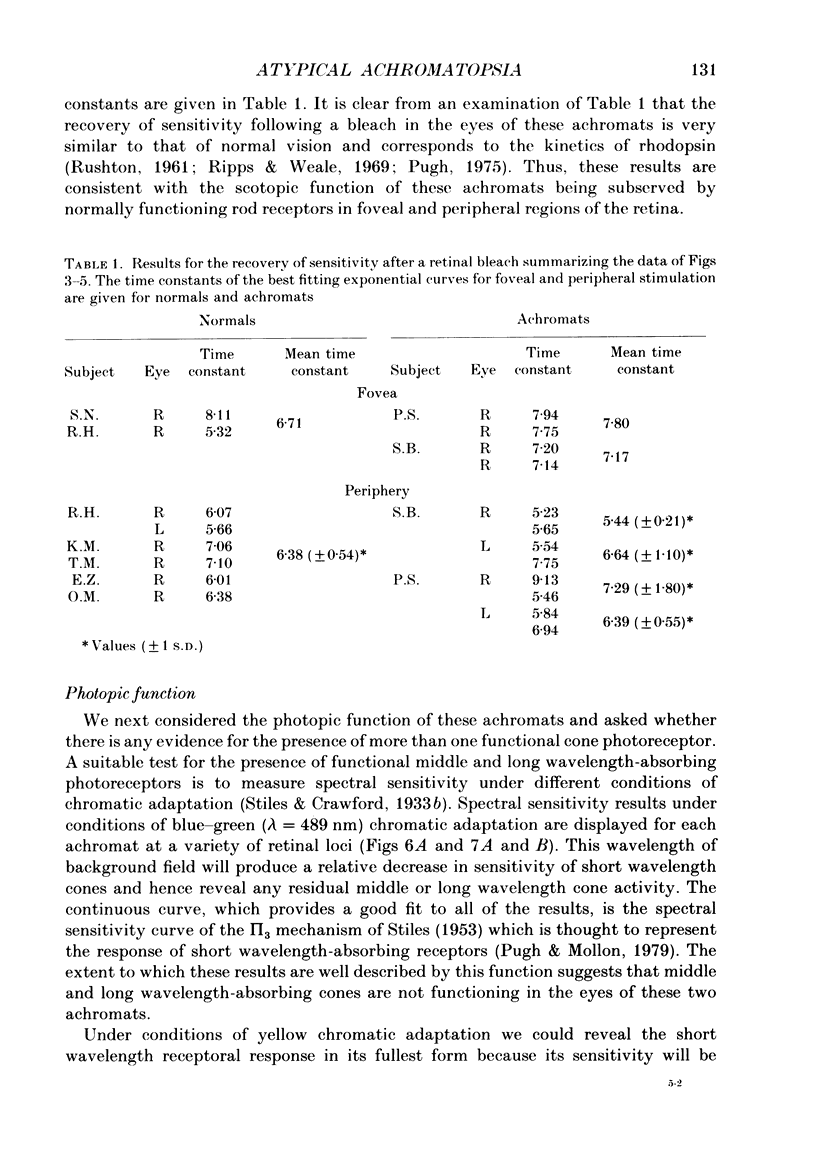
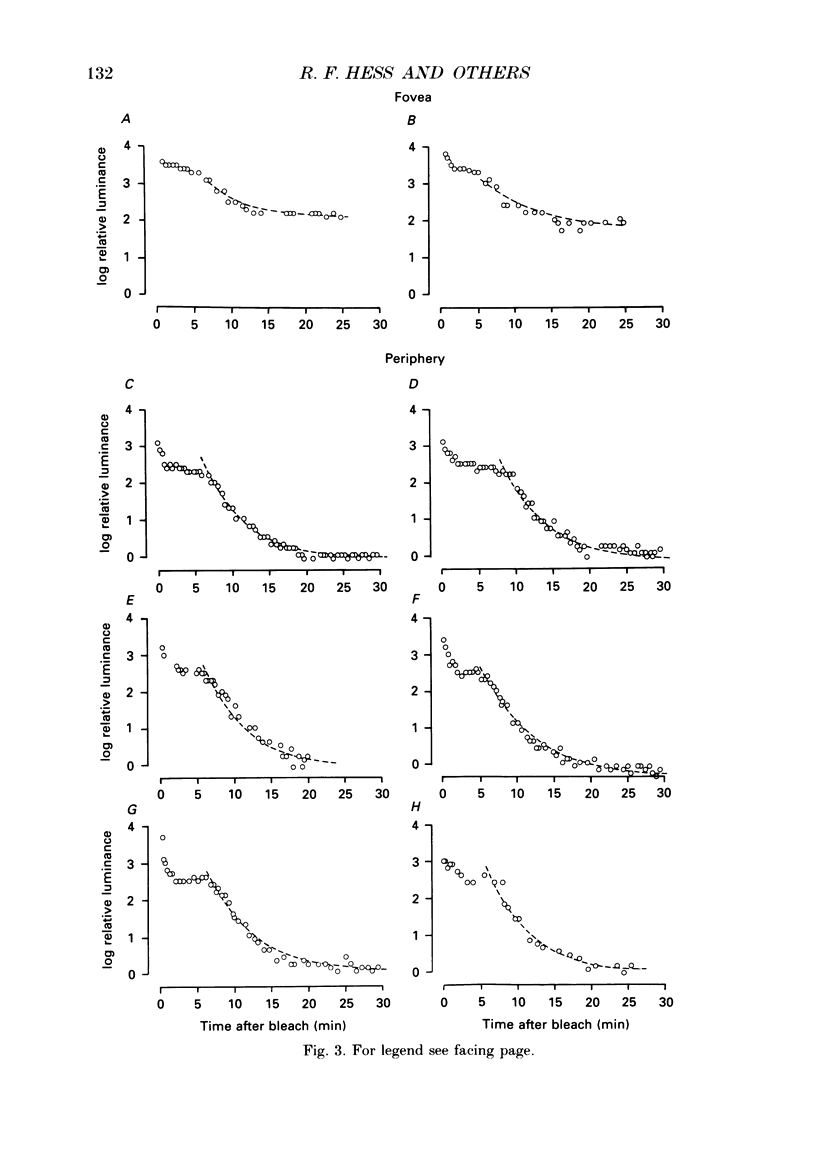
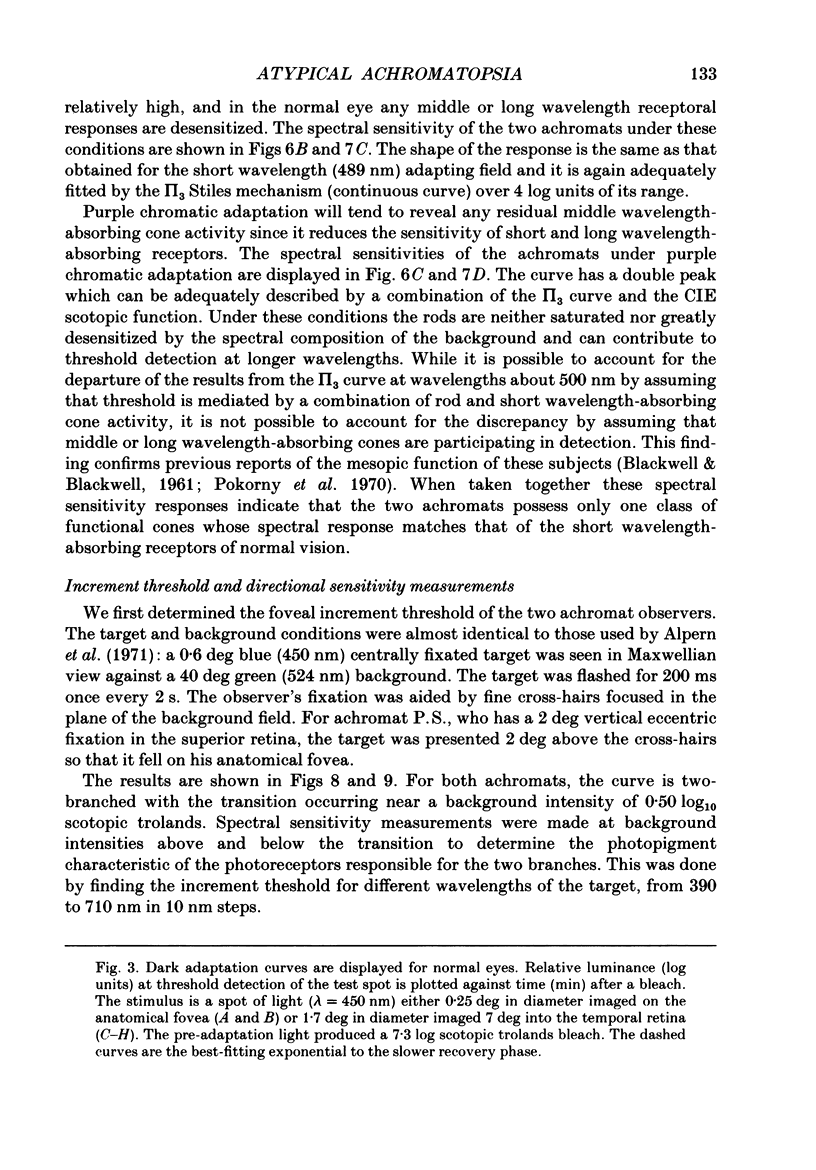
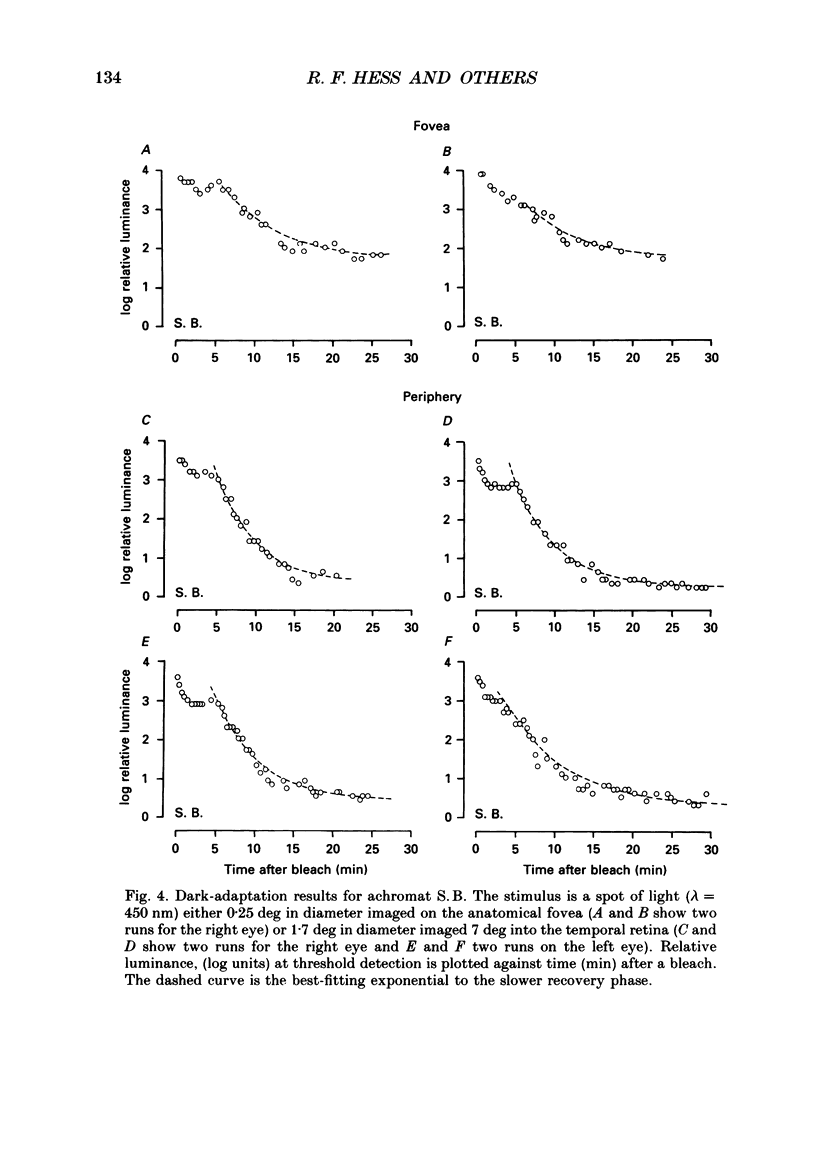
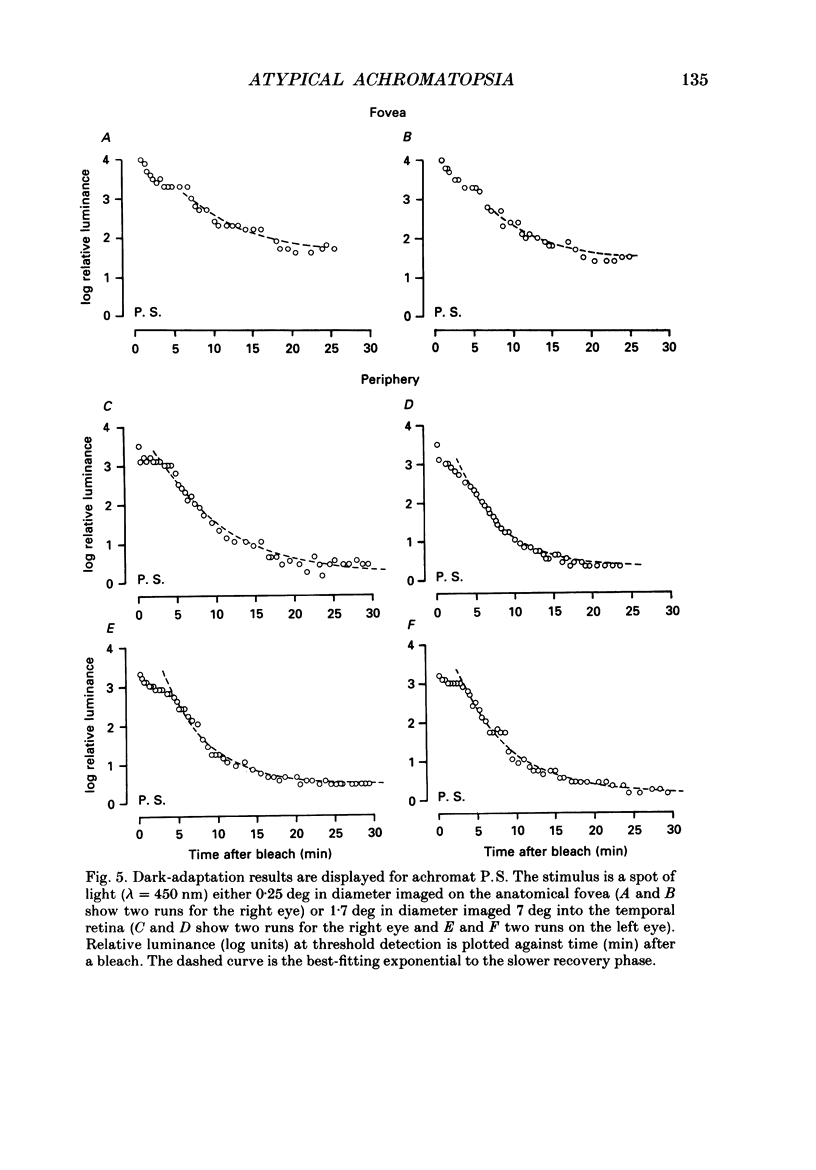
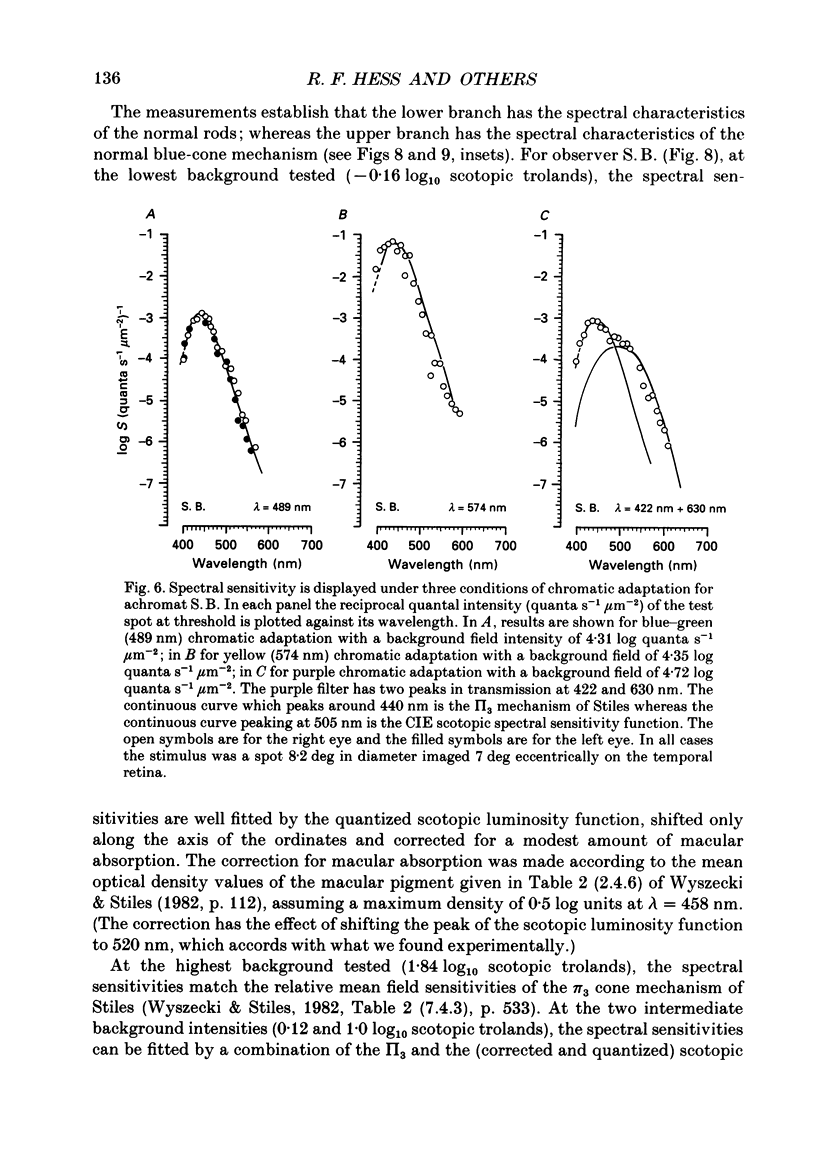
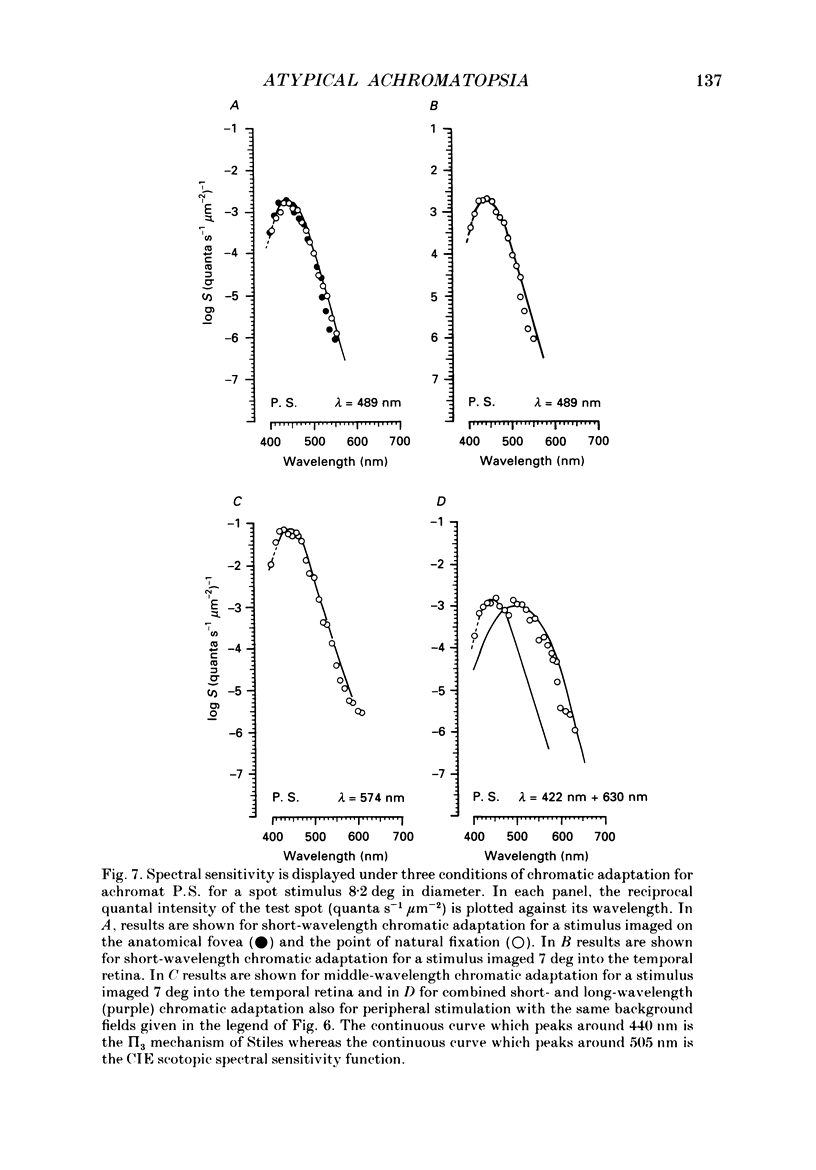
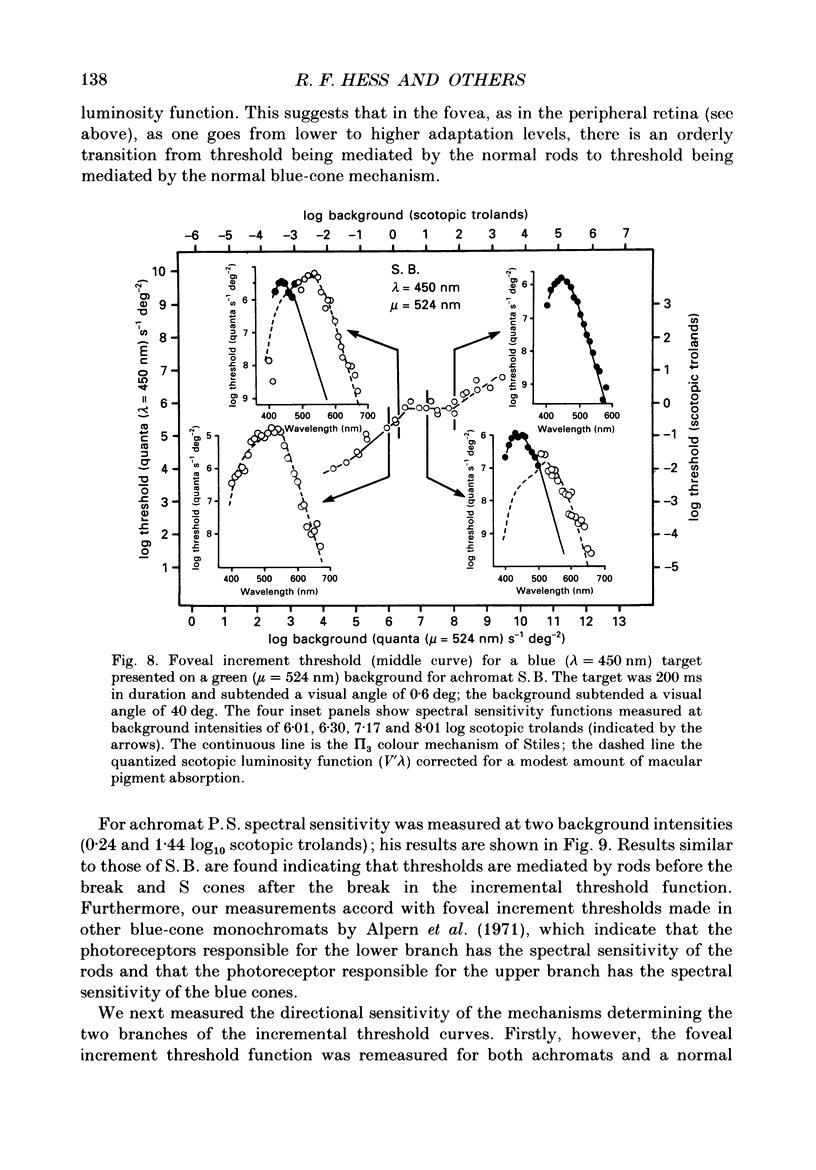
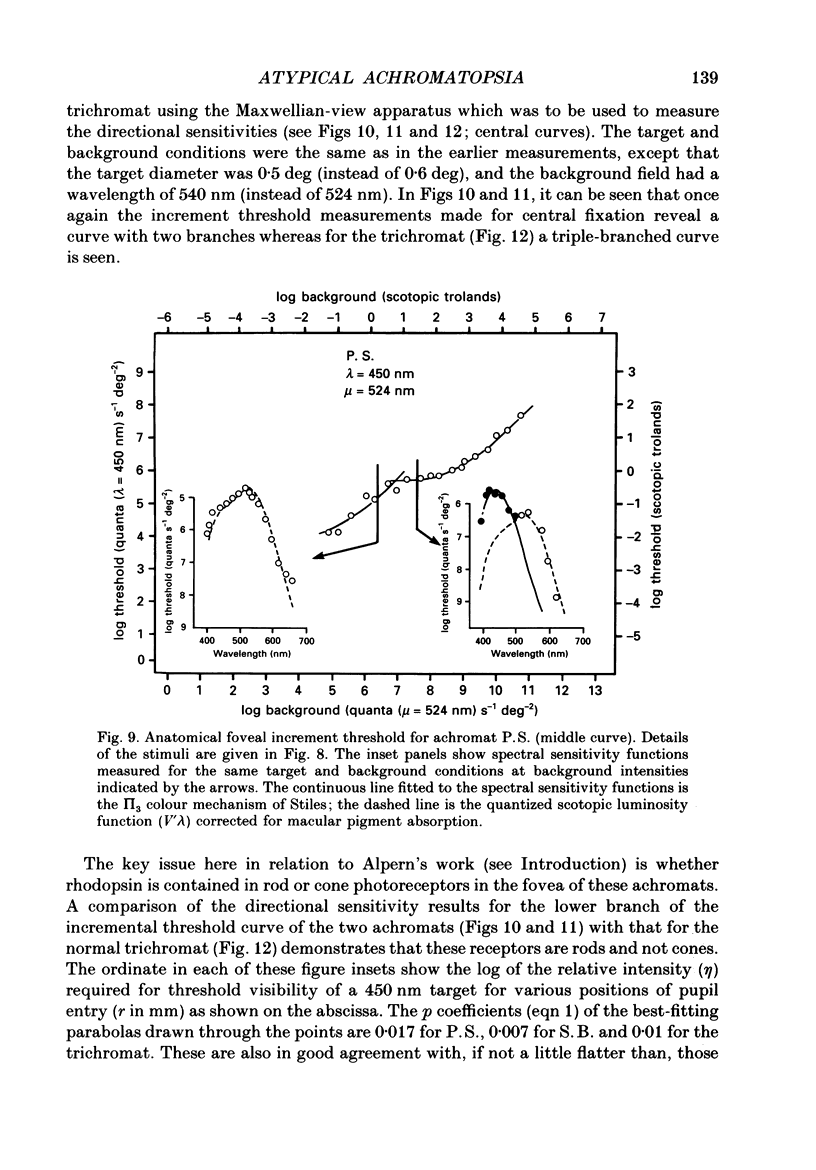
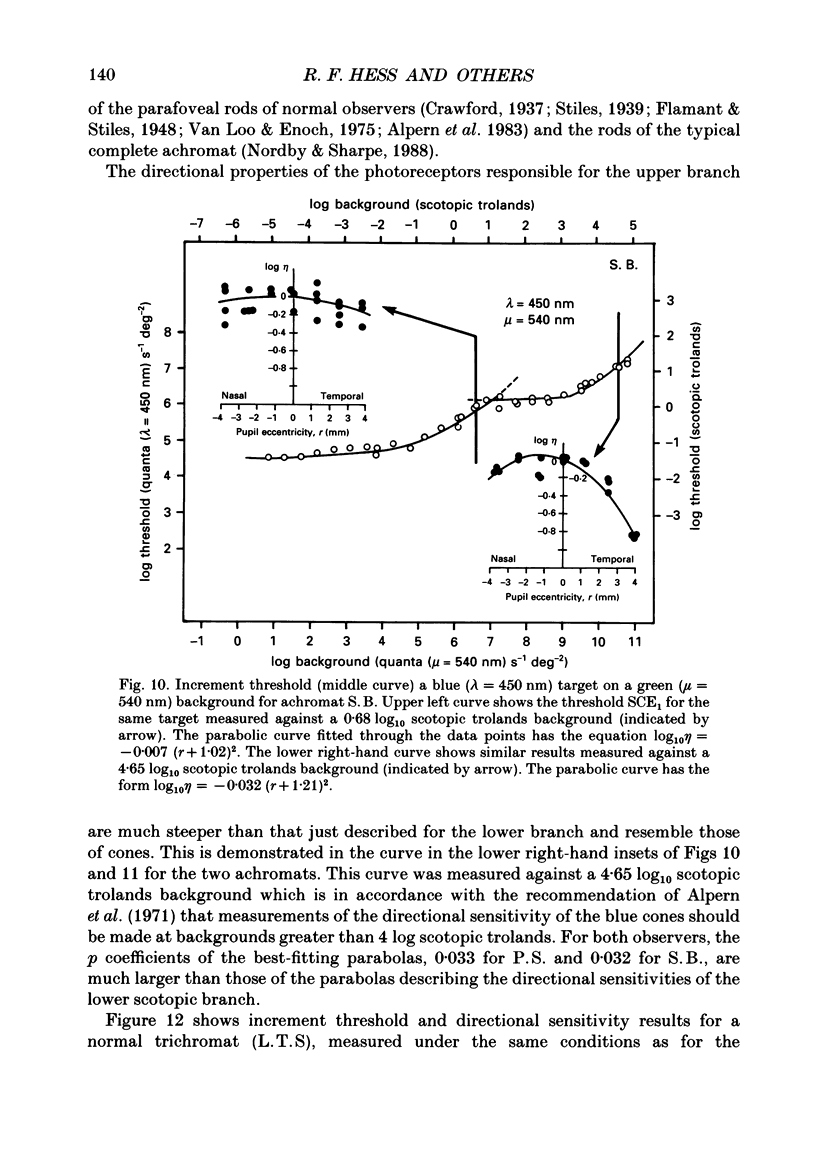
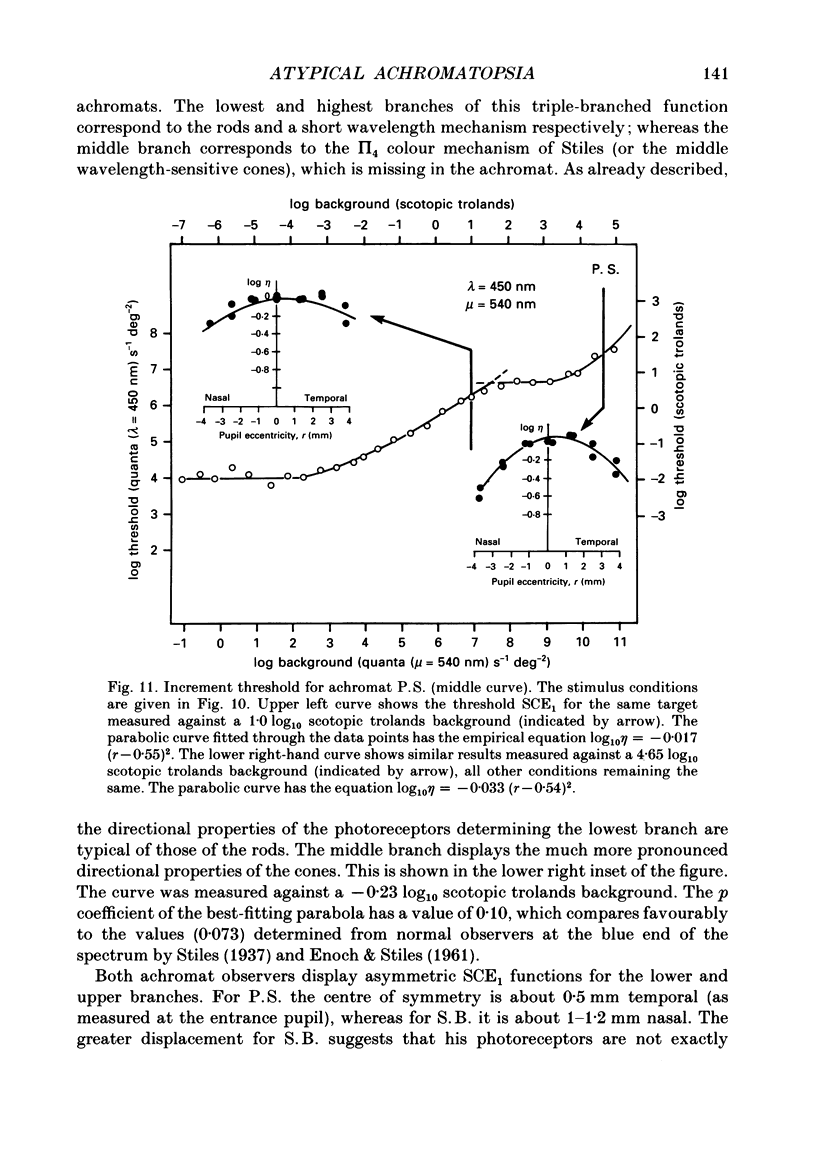
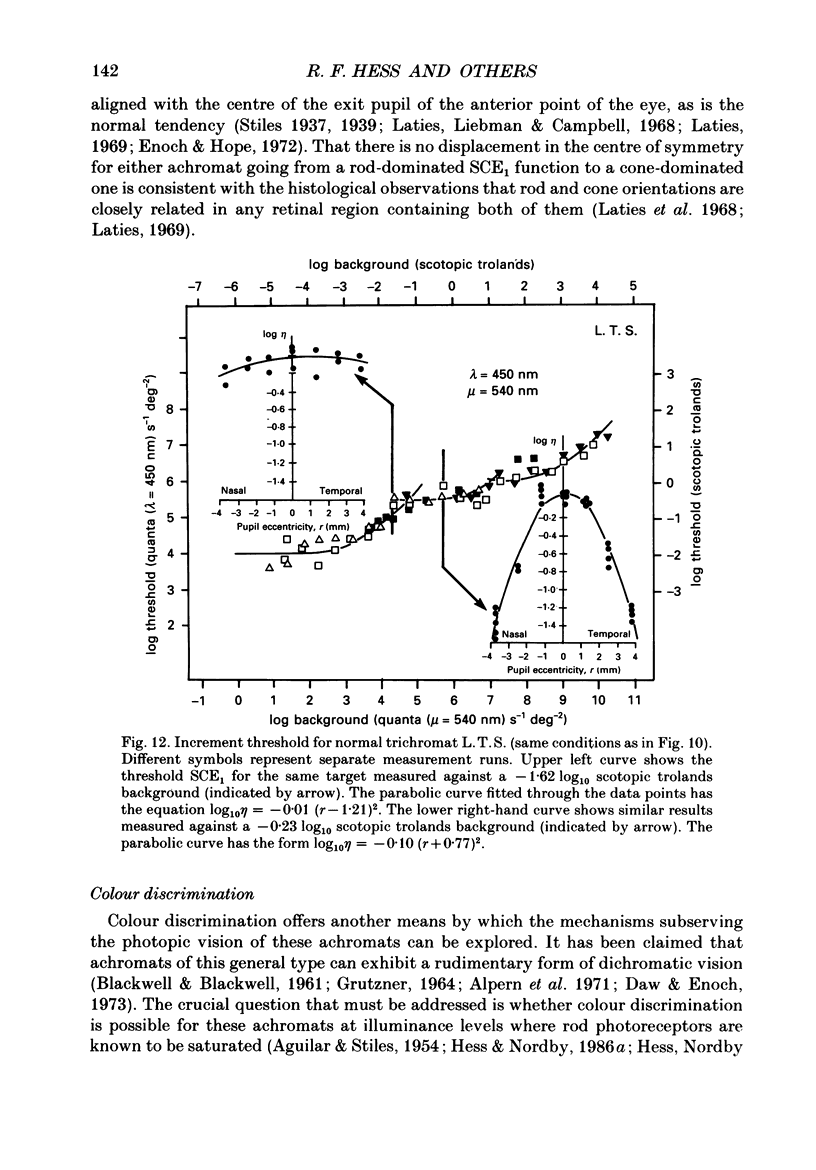
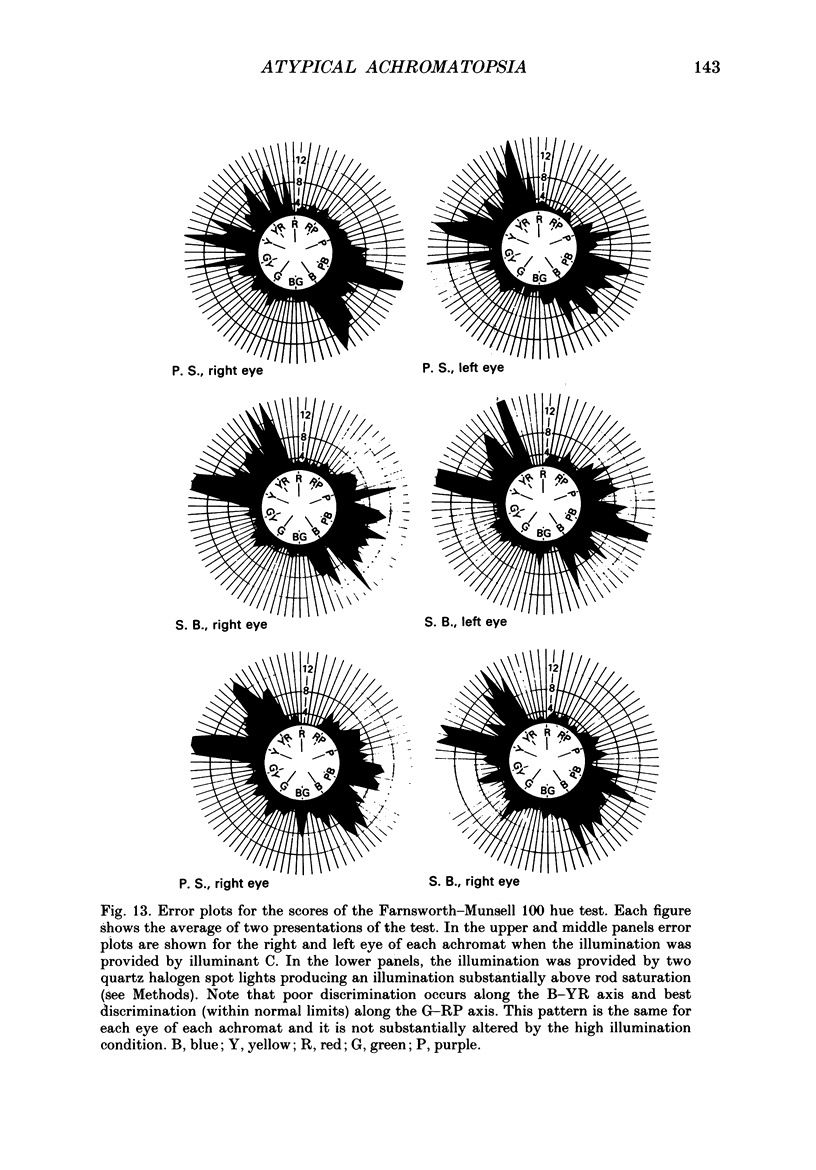
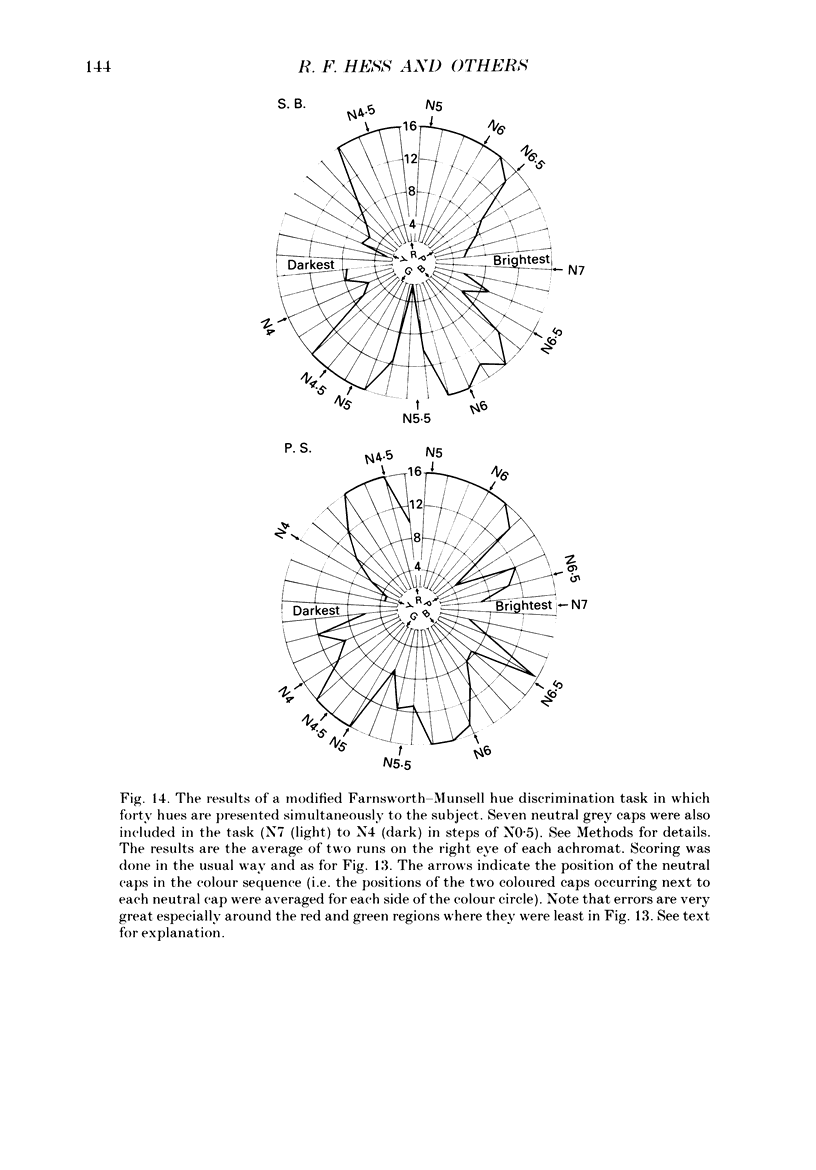
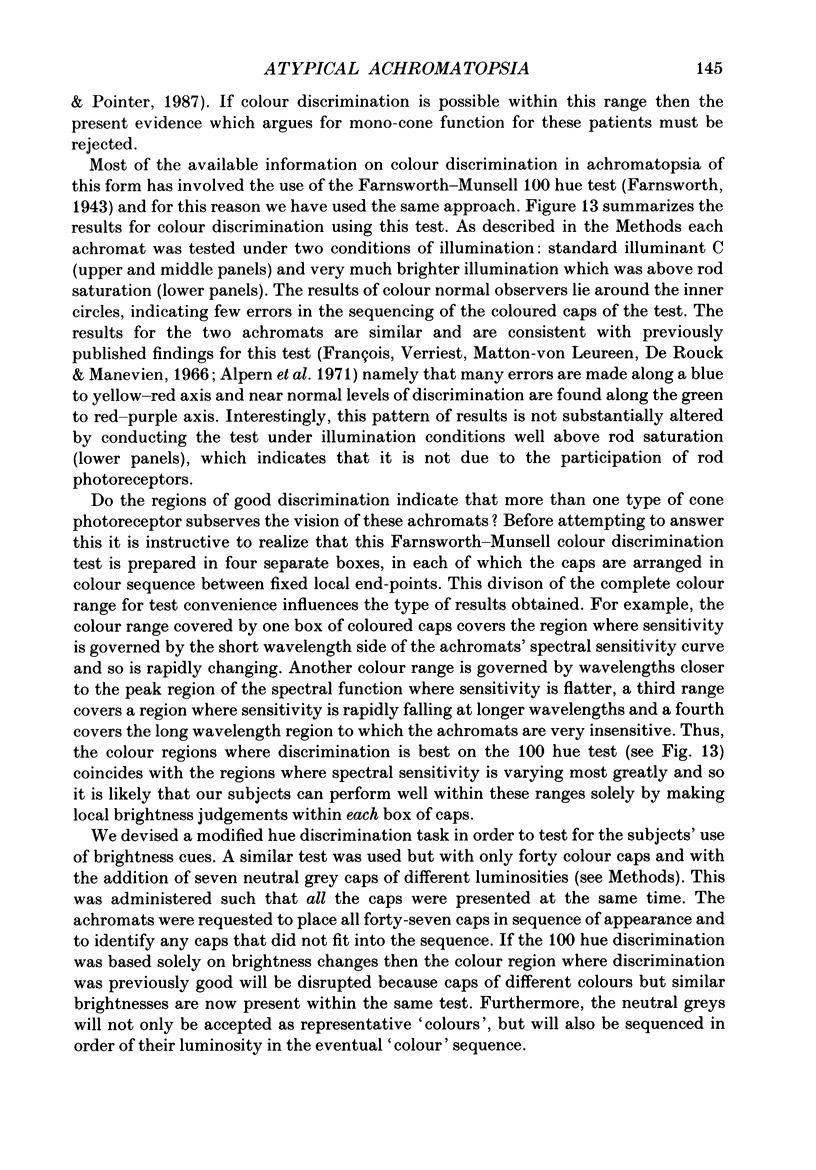
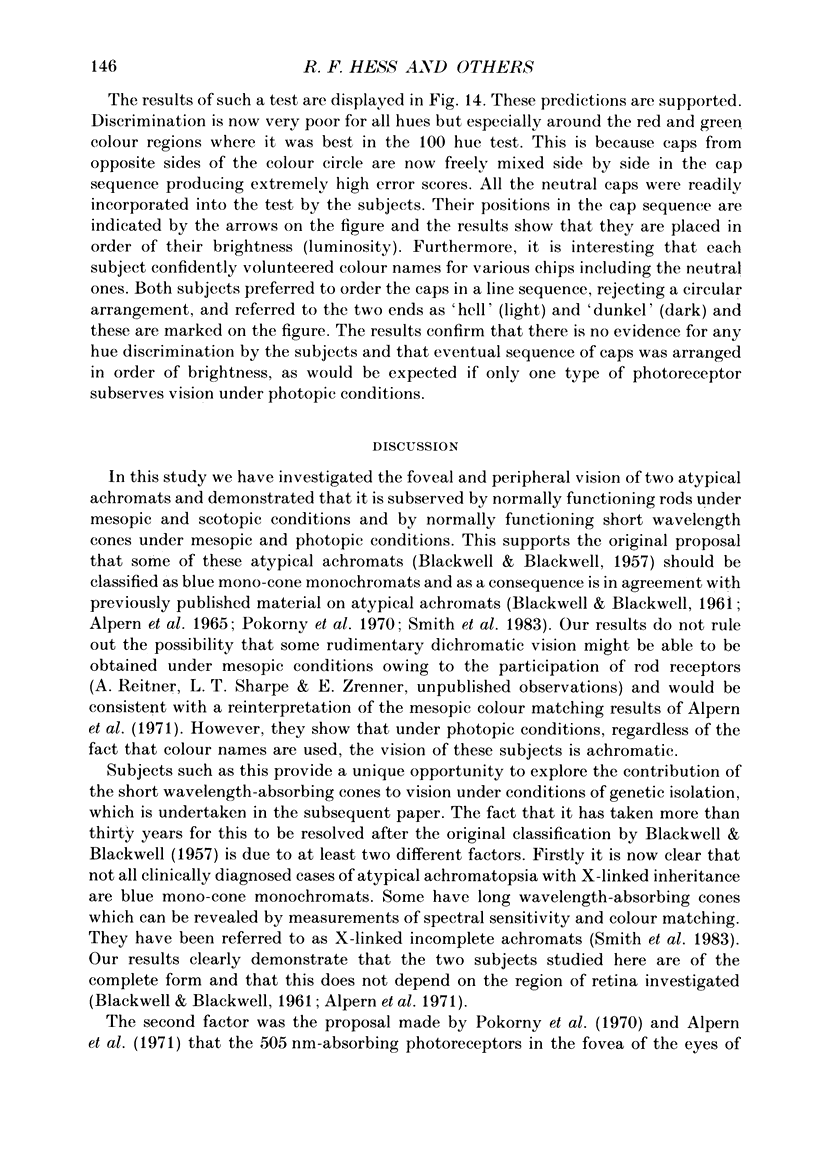
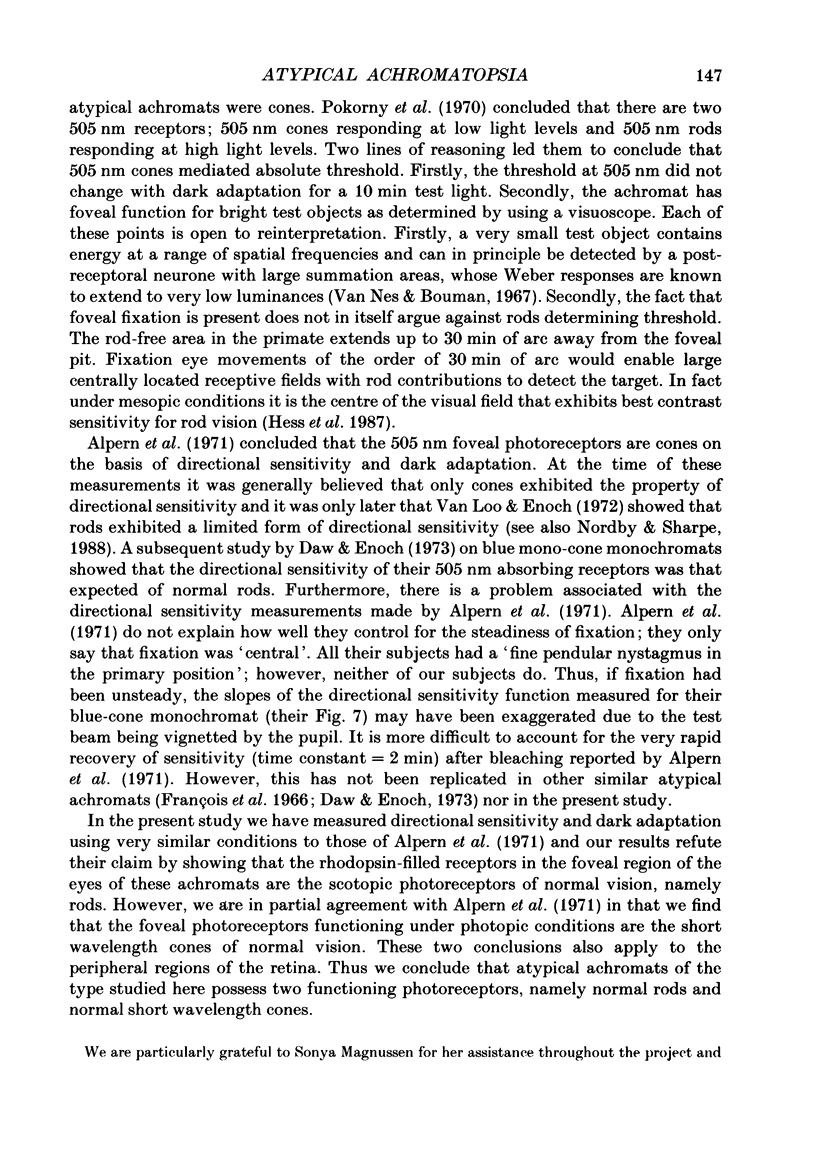
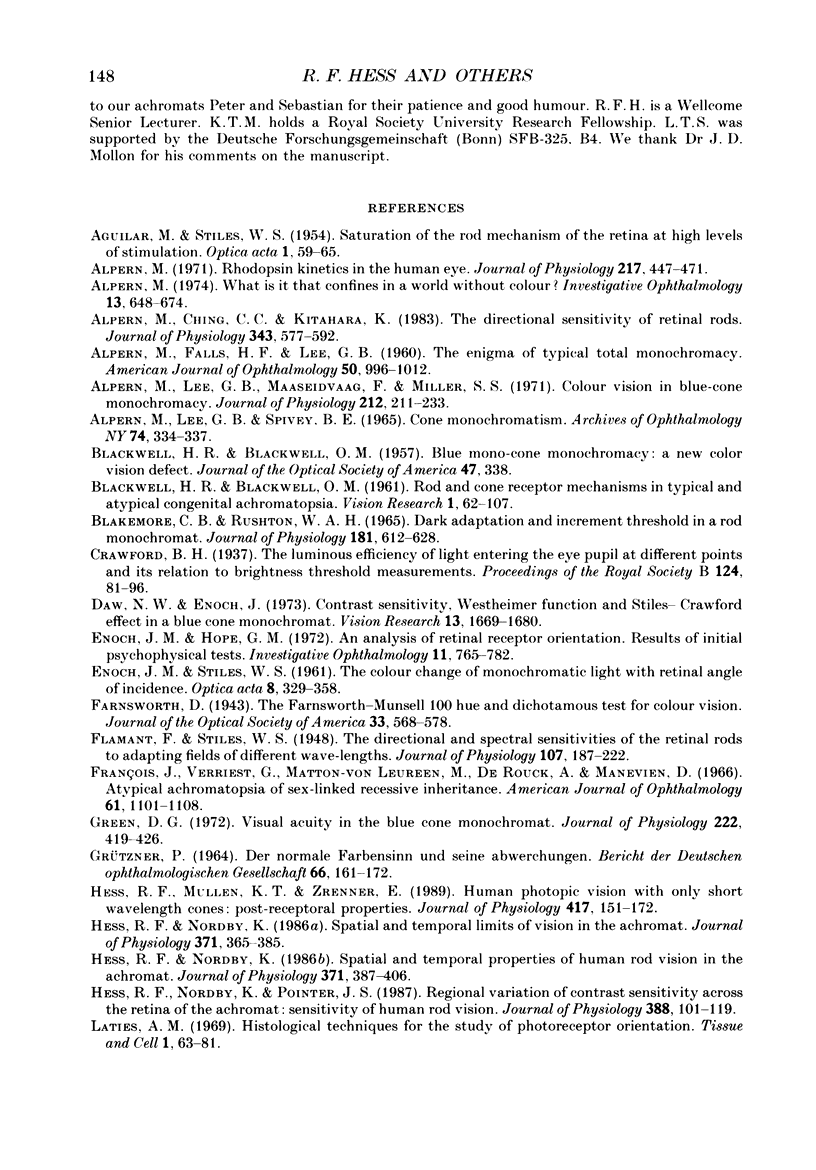
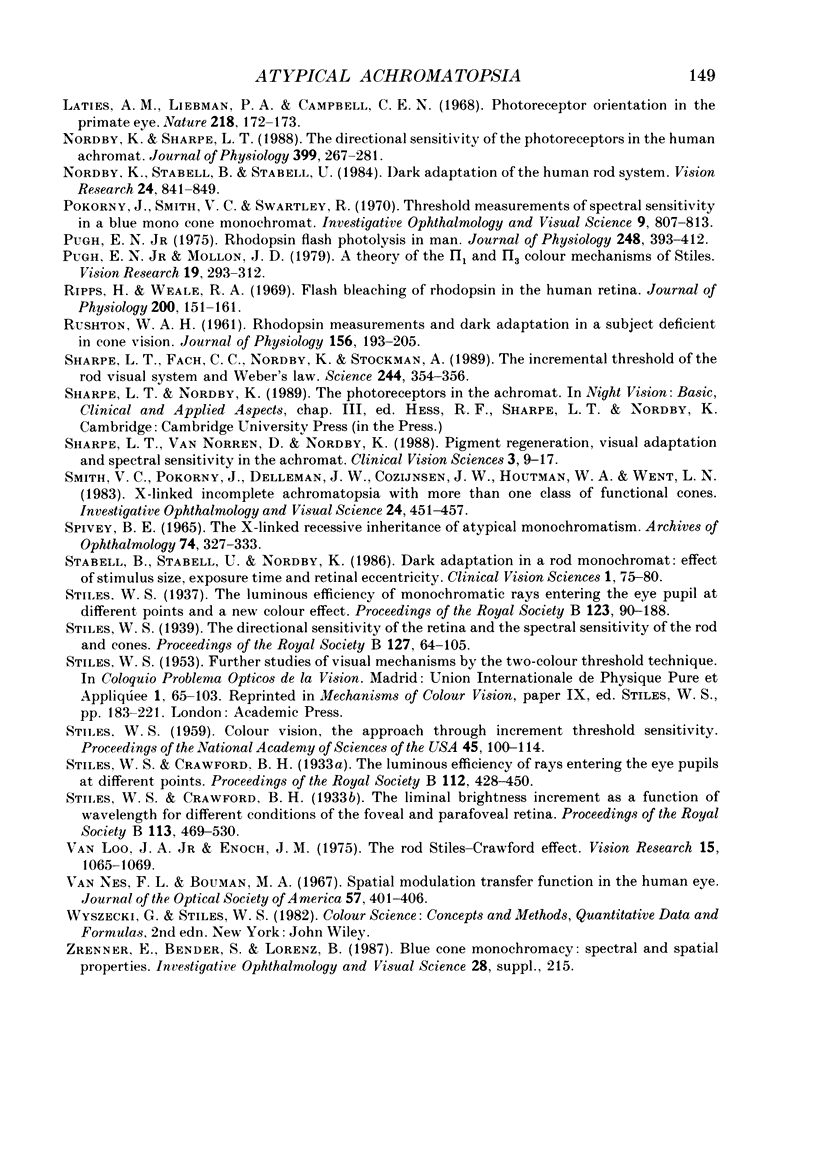
Images in this article
Selected References
These references are in PubMed. This may not be the complete list of references from this article.
- ALPERN M., FALLS H. F., LEE G. B. The enigma of typical total monochromacy. Am J Ophthalmol. 1960 Nov;50:996–1012. doi: 10.1016/0002-9394(60)90353-6. [DOI] [PubMed] [Google Scholar]
- ALPERN M., LEE G. B., SPIVEY B. E. PI-1 CONE MONOCHROMATISM. Arch Ophthalmol. 1965 Sep;74:334–337. doi: 10.1001/archopht.1965.00970040336008. [DOI] [PubMed] [Google Scholar]
- Alpern M., Ching C. C., Kitahara K. The directional sensitivity of retinal rods. J Physiol. 1983 Oct;343:577–592. doi: 10.1113/jphysiol.1983.sp014911. [DOI] [PMC free article] [PubMed] [Google Scholar]
- Alpern M., Lee G. B., Maaseidvaag F., Miller S. S. Colour vision in blue-cone 'monochromacy'. J Physiol. 1971 Jan;212(1):211–233. doi: 10.1113/jphysiol.1971.sp009318. [DOI] [PMC free article] [PubMed] [Google Scholar]
- Alpern M. What is it that confines in a world without color? Invest Ophthalmol. 1974 Sep;13(9):648–674. [PubMed] [Google Scholar]
- Blakemore C. B., Rushton W. A. Dark adaptation and increment threshold in a rod monochromat. J Physiol. 1965 Dec;181(3):612–628. doi: 10.1113/jphysiol.1965.sp007786. [DOI] [PMC free article] [PubMed] [Google Scholar]
- Daw N. W., Enoch J. M. Contrast sensitivity, Westheimer function and Stiles-Crawford effect in a blue cone monochromat. Vision Res. 1973 Sep;13(9):1669–1680. doi: 10.1016/0042-6989(73)90086-2. [DOI] [PubMed] [Google Scholar]
- ENOCH J. M., STILES W. S. The colour change of monochromatic light with retinal angle of incidence. Optom Wkly. 1961 Oct;8(52):329–358. doi: 10.1080/713826396. [DOI] [PubMed] [Google Scholar]
- Enoch J. M., Hope G. M. An analysis of retinal receptor orientation. 3. Results of initial psychophysical tests. Invest Ophthalmol. 1972 Sep;11(9):765–782. [PubMed] [Google Scholar]
- Flamant F., Stiles W. S. The directional and spectral sensitivities of the retinal rods to adapting fields of different wave-lengths. J Physiol. 1948 Mar 15;107(2):187–202. doi: 10.1113/jphysiol.1948.sp004262. [DOI] [PMC free article] [PubMed] [Google Scholar]
- François J., Verriest G., Matton-Van Leuven T., De Rouck A., Manavian D. Atypical achromatopia of sex-linked recessive inheritance. Am J Ophthalmol. 1966 May;61(5 Pt 2):1101–1108. doi: 10.1016/0002-9394(66)90231-5. [DOI] [PubMed] [Google Scholar]
- Green D. G. Visual acuity in the blue cone monochromat. J Physiol. 1972 Apr;222(2):419–426. doi: 10.1113/jphysiol.1972.sp009806. [DOI] [PMC free article] [PubMed] [Google Scholar]
- Hess R. F., Mullen K. T., Zrenner E. Human photopic vision with only short wavelength cones: post-receptoral properties. J Physiol. 1989 Oct;417:151–172. doi: 10.1113/jphysiol.1989.sp017795. [DOI] [PMC free article] [PubMed] [Google Scholar]
- Hess R. F., Nordby K., Pointer J. S. Regional variation of contrast sensitivity across the retina of the achromat: sensitivity of human rod vision. J Physiol. 1987 Jul;388:101–119. doi: 10.1113/jphysiol.1987.sp016604. [DOI] [PMC free article] [PubMed] [Google Scholar]
- Hess R. F., Nordby K. Spatial and temporal limits of vision in the achromat. J Physiol. 1986 Feb;371:365–385. doi: 10.1113/jphysiol.1986.sp015981. [DOI] [PMC free article] [PubMed] [Google Scholar]
- Hess R. F., Nordby K. Spatial and temporal properties of human rod vision in the achromat. J Physiol. 1986 Feb;371:387–406. doi: 10.1113/jphysiol.1986.sp015982. [DOI] [PMC free article] [PubMed] [Google Scholar]
- Laties A. M., Liebman P. A., Campbell C. E. Photoreceptor orientation in the primate eye. Nature. 1968 Apr 13;218(5137):172–173. doi: 10.1038/218172a0. [DOI] [PubMed] [Google Scholar]
- Nordby K., Sharpe L. T. The directional sensitivity of the photoreceptors in the human achromat. J Physiol. 1988 May;399:267–281. doi: 10.1113/jphysiol.1988.sp017079. [DOI] [PMC free article] [PubMed] [Google Scholar]
- Nordby K., Stabell B., Stabell U. Dark-adaptation of the human rod system. Vision Res. 1984;24(8):841–849. doi: 10.1016/0042-6989(84)90156-1. [DOI] [PubMed] [Google Scholar]
- Pokorny J., Smith V. C., Swartley R. Threshold measurements of spectral sensitivity in a blue monocone monochromat. Invest Ophthalmol. 1970 Oct;9(10):807–813. [PubMed] [Google Scholar]
- Pugh E. N., Jr, Mollon J. D. A theory of the pi1 and pi3 color mechanisms of Stiles. Vision Res. 1979;19(3):293–312. doi: 10.1016/0042-6989(79)90175-5. [DOI] [PubMed] [Google Scholar]
- Pugh E. N. Rhodopsin flash photolysis in man. J Physiol. 1975 Jun;248(2):393–412. doi: 10.1113/jphysiol.1975.sp010981. [DOI] [PMC free article] [PubMed] [Google Scholar]
- RUSHTON W. A. Rhodopsin measurement and dark-adaptation in a subject deficient in cone vision. J Physiol. 1961 Apr;156:193–205. doi: 10.1113/jphysiol.1961.sp006668. [DOI] [PMC free article] [PubMed] [Google Scholar]
- Ripps H., Weale R. A. Flash bleaching of rhodopsin in the human retina. J Physiol. 1969 Jan;200(1):151–159. doi: 10.1113/jphysiol.1969.sp008686. [DOI] [PMC free article] [PubMed] [Google Scholar]
- SPIVEY B. E. THE X-LINKED RECESSIVE INHERITANCE OF ATYPICAL MONOCHROMATISM. Arch Ophthalmol. 1965 Sep;74:327–333. doi: 10.1001/archopht.1965.00970040329007. [DOI] [PubMed] [Google Scholar]
- Sharpe L. T., Fach C., Nordby K., Stockman A. The incremental threshold of the rod visual system and Weber's law. Science. 1989 Apr 21;244(4902):354–356. doi: 10.1126/science.2711186. [DOI] [PubMed] [Google Scholar]
- Smith V. C., Pokorny J., Delleman J. W., Cozijnsen M., Houtman W. A., Went L. N. X-linked incomplete achromatopsia with more than one class of functional cones. Invest Ophthalmol Vis Sci. 1983 Apr;24(4):451–457. [PubMed] [Google Scholar]



